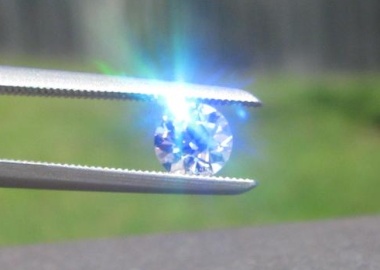Over the past 18 months, we have been stocking a good number of diamonds with fluorescence. In days gone by, high colour diamonds with strong fluorescence were marketed as “blue-white” diamonds and commanded a premium. In modern times however, fluorescence has been typically frowned upon by the trade and therefore consumers. However, is this about to change?
Over the past year, I’ve heard some pretty crazy things from people in the trade about fluorescence. One jeweller told a client that fluorescence will make a diamond go black over time. Another so-called “lab-director” of a Sydney based grading lab which touts itself as the only lab to grade transparency said one of our diamonds lacked transparency due to the presence of strong blue fluorescence – without even seeing the diamond!
However, lately I have noticed that there seems to have been a genuine change in thinking about fluorescence within the trade.
The seminal study of the visible effects of fluorescence appeared in the Winter 1997 edition of Gems & Gemology. This showed that in the vast majority of cases fluorescence has no noticeable effect on the diamond, and in some cases, people actually preferred fluorescent diamonds over non-fluorescent diamonds.
In general, the main argument that these “anti-fluorescents” use is that fluorescence causes haziness when subjected to ultra violet light, eg: sunlight. However, I have yet to personally witness a diamond that visibly lacks transparency due to fluorescence. Perhaps I have lived a sheltered life in terms of hazy stones, but I’d be willing to bet that more diamonds lack transparency due to other factors such as inclusions or graining than fluorescence.
The reality is that, in my opinion, fluorescence gives a stone more life, especially in Australia, where we tend to have more sunlight than say Europe. As an added bonus, blue fluorescence makes lower coloured diamonds whiter. However, the real paradox in my opinion comes from the fact that the trade heavily discounts fluorescent diamonds. Whilst I have seen some wholesalers give little to no discounts to fluorescent stones, some large manufacturers, particularly in India and Israel, give crazy discounts, even to diamonds with faint or medium blue fluorescent diamonds. These same manufacturers even grade transparency, and despite these fluorescent diamonds earning the top transparency grade, they are still willing to sell their diamonds at these crazy discounts.

Above: A fluorescent diamond in sunlight
A video we filmed in January 2008
Now, in the past week, the GIA have come to the fluorescence party. This page outlines the facts about fluorescence, whilst this page will be included with every GIA report. Hopefully, with the GIA educating consumers and including easy to read brochures about the facts on fluorescence with their reports, these “anti-fluorescents” will be silenced and more fluorescent diamonds will be sold. Perhaps now is the time to buy a fluorescent diamond in the expectation that prices will rise??
June 18th, 2010 at 10:09 am
Really great info- Thank you!
August 17th, 2010 at 1:45 pm
Very informative blog…
November 17th, 2013 at 1:28 pm
Nikhil your site is great and your blogs are interesting and to the point.
Have you studied Gemmology at GIA or GAA Perth and have you done a formal diamond course. From the way you write it makes me believe that you are well educated in this field and have many years of experience.
I must come and visit your office and workshop. I will make an appointment.
January 19th, 2014 at 3:07 am
It is all about the perception. If majority of customers think that fluorescent diamond is less valuable they will only buy it with the discount.